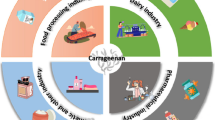Abstract
The lipids metabolism of tomato and bean plants during biological control of wilt pathogens (Fusarium oxysporum f.sp.lycopersici andF. oxysporum f.sp.phaseoli, respectively) byBacillus subtilis was investigated. The interaction of wilt pathogens with both tomato and bean caused an imbalance and drastic reduction in total lipids, triacylglycerol, sterol and all phospholipd fractions except phosphatidic acid. The application of a formulated biocontrol agent,B. subtilis, eliminated the detrimental effect of both wilt pathogens and consequently prevented catabolism of lipid fractions in both tomato and bean. Moreover, the changes in the lipid fractions as a sensitive monitor for biocontrol of wilt diseases suggest a positive correlation between the application ofB. subtilis and improvement in the host metabolism towards anabolism.
Similar content being viewed by others
References
Abd-Allah, E.F. (2005) Effect of aBacillus subtilis isolate on southern blight (Sclerotium rolfsii) and lipid composition of peanut seeds.Phytoparasitica 33:460–466.
Abd-Allah, F.F., El-Didamony, G. and Sarhan, M.M. (1997) Biological control ofFusarium oxysporum in bean byBacillus subtilis.Egypt. J. Phytopathol. 25:71–83.
Abd-Allah, E.F. and Ezzat, S.M. (2004) Role of lipid metabolism through bioremediation of fusaric acid in germinating peanut seedlings.Phytoparasitica 32:38–42.
Amenta, J.S. (1964) A rapid method for quantification of lipids separated by thin layer chromatography.J. Lipid Res. 5:270–272.
Cachorro, P., Ortiz, A. and Cerda, A. (1993) Effect of saline stress and calcium on lipid composition in bean roots.Phytochemistry 32:1131–1136.
Daniel, W.W. (1987) Biostatistics: A Foundation for Analysis in the Health Sciences. 4th ed. John Wiley and Sons, New York, NY. pp. 292–293.
El-Banoby, F.E. and Rudolf, K. (1979) A polysaccharide from liquid cultures ofPseudomonas phaseolicola which specifically induces water-soaking in bean leaves (Phaseolus vulgaris L.).Phytopathol. Z. 95:38–50.
El-Hoseiny, M.M. and Rabie, M.R. (1979) Effect of bacterization of maize (Zea mays) withAzotobacter chroococcum on their growth.Egypt. J. Microbiol. 14:45–57.
Fölch, J., Lees, M. and Sloane-Stanley, G.H. (1957) A simple method for the isolation and purification of total lipids from animal tissues.J. Biol. Chem. 226:497–509.
Hegazy, H.S. and Lösel, D.M. (1992) Effect of bacterial infection on plant lipid metabolism.Proc. Tenth International Symp. on Plant Lipids (Jerba, Tunisia), pp. 331–334.
Hitchcock, C. (1975) Structure and distribution of plant acyl lipids.in: Galliard, T. and Mercer, E.I. [Eds.] Recent Advances in the Chemistry and Biochemistry of Plant Lipids. Academic Press, New York, NY. pp. 1–19.
Hitchcock, C. and Nichols, B.W. [Eds.] (1971) Plant Lipid Biochemistry. Academic Press, New York, NY. p. 68.
Jiang, H.F. and Duan, N.X. (1997) [Further identification and comprehensive evaluation of pre-selected groundnut germplasm.]Oil Crops of China 19:57–59 (Chinese; English abstract inCAB Abstracts 1996–1998/07).
Kates, M. and Marshall, M.O. (1975) Biosynthesis of phosphoglycerides in plants.in: Galliard, T. and Mercer, E.I. [Eds.] Recent Advances in the Chemistry and Biochemistry of Plant Lipids. Academic Press, New York, NY. pp. 115–159.
Mahadevan, A. [Ed.] (1984) Growth Regulators and Diseased Plants. Mohan Primlani for Oxford & IBH Publishing Co., New Delhi, India.
Marsh, J.B. and Weinstein, D.B. (1966) Simple charring method for determination of lipids.J. Lipid Res. 7:574–576.
Mazliak, P., Douady, D., Demandre, C. and Kader, J.C. (1975) Exchange processes between organelles involved in membrane lipid biosynthesis.in: Galliard, T. and Mercer, E.I. [Eds.] Recent Advances in the Chemistry and Biochemistry of Plant Lipids. Academic Press, New York, NY. pp. 301–318.
Miraazimova, K.H.T., Gusakova, S.D. and Glushenkova, A.I. (1997) Post-infectional changes on the phospholipids of the leaves of cotton plant variety resistant toVerticillium dahliae.Chem. Nat. Compd. (Engl. Transl. Khim. Prir. Soedin.) 33:156–161.
Navari-Izzo, F., Quartacci, M.F. and Izzo, R. (1993) Lipid composition of plasma membranes isolated from sunflower seedlings grown under water stress.Physiol. Plant. 87:508–514.
Radwan, S.S. and Mangold, H.K. (1976) The lipids of plant tissue cultures.Adv. Lipid Res. 12:171–211.
Rouser, G., Fleischer, S. and Yamamoto, A. (1970) Two dimensional thin layer chromatographic separation of polar lipids and determination of phospholipids and phosphorus analysis of spots.Lipids 5:494–496.
Talboys, P.W. (1968) Water deficit in vascular diseases.in: Kozlowski, T.T. [Ed.] Water Deficits and Plant Growth. Academic Press, New York, NY. pp. 255–311.
Whitney, P.J. (1976) Disturbance of host metabolism.in: Whitney, P.J. [Ed.] Microbial Plant Pathology. Academic Press, New York, NY. pp. 109–132.
Yamada, T. (1987) Lipid peroxidation during the development of pine wilt disease.Ann. Phytopathol. Soc. Jpn. 53:523–530.
Yunusova, S.G., Gusakova, S.D., Miraazimova, K.T., Glushenkova, A.I., Usmanov, S.A. and Ikramov, Y. (1992) Effect of a wilt infection on the neutral lipids of cotton leaves.Chem. Nat. Compd. (Engl. Transl. Khim. Prir. Soedin.) 28:414–420.
Zeller, W., Rudolph, K. and Hoppe, H.-H. (1976) Effect ofPseudomonas phaseolicola toxin on the composition of lipids in leaves of swiss chard (Beta vulgaris L.).Phytopathol. Z. 86:205–214.
Author information
Authors and Affiliations
Corresponding author
Additional information
http://www.phytoparasitica.org posting Sept. 20, 2006.
Rights and permissions
About this article
Cite this article
Abd-Allah, E.F., Hashem, A. & Ezzat, S.M. Lipid metabolism in tomato and bean as a sensitive monitor for biocontrol of wilt diseases. Phytoparasitica 34, 516–522 (2006). https://doi.org/10.1007/BF02981208
Received:
Accepted:
Issue Date:
DOI: https://doi.org/10.1007/BF02981208




